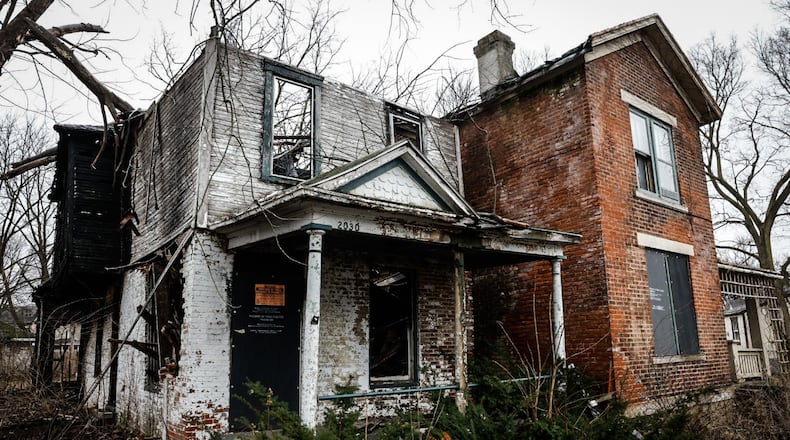The grant funding also will help remove smaller amounts of blight in Trotwood, Riverside, Miamisburg, Englewood, Perry Twp. and Clayton, plus it will help remediate environmental issues in a couple of empty downtown Dayton office towers to try to prepare them for redevelopment.
“The challenge in the community is still significant — there’s still a significant number of properties that still need to be removed,” said Mike Grauwelman, executive director of the Montgomery County Land Bank. “But incrementally, we’re making significant strides, and there is hope and some effort to make this an ongoing program.”
Credit: JIM NOELKER
Credit: JIM NOELKER
The Montgomery County Land Bank applied for and received more than $11 million in funding from the Ohio Building Demolition and Site Revitalization Program.
The funds will help bulldoze or environmentally remediate about 173 properties in Dayton; 32 in Trotwood; 30 in Harrison Twp.; 13 in Jefferson Twp.; and six each in Riverside and West Carrolton, according to information from the land bank. A small number of the properties are in Miamisburg, Clayton, Perry Twp. and Englewood.
Under the state program, every county in the state was guaranteed to receive at least $500,000 in state support.
But the Montgomery County Land Bank always hoped to receive a much larger award, and the organization began demolishing properties last spring to be proactive. Now some of that work could be reimbursed.
The land bank said it has 87 buildings under contract for demolition, and the vast majority already have been taken down.
The grant program requires a local match of 25%, and the land bank will provide partial funding for some of the work, but local jurisdictions also will be expected to pitch in.
The land bank and community match could be around $4 million.
Credit: JIM NOELKER
Credit: JIM NOELKER
In addition to residential and commercial demolition, the state allows this grant funding to be used to remove asbestos, interior walls, dysfunctional utility systems and fix other problems to help reposition commercial buildings for redevelopment, Grauwelman said.
Grauwelman said some grant money will help complete asbestos remediation of 34 N. Main St. in downtown, which is a 14-story office building that once operated as the Third National Bank and Trust and later was renamed the Paru Tower.
The classically styled office building has sat vacant for years, and multiple efforts to redevelop it did not succeed. The land bank now holds the title to the office building, which prevents it from continuing to accumulate more and more delinquent taxes.
State grant funds also will help clean up the Centre City building at 40 S. Main St., which also has been empty for years, despite multiple plans to repurpose it.
A couple of the firms that are rehabbing the Dayton Arcade have proposed converting the 21-story tower into housing and other uses.
The land bank hopes to basically help gut these properties, Grauwelman said, and cleanup activities could include mold elimination and the removal of outdated HVAC systems.
City of Dayton efforts
About $7 million of the state funds are expected to benefit Dayton, officials said, which will help the city achieve its goal of tearing down more than 1,000 nuisance and troubled properties in the next several years.
The city is paying for these demolition activities using federal COVID relief funds, federal Community Development Block Grant funds, general fund money and state assistance.
The city’s expected investment in demolition will exceed $20 million.
However, the city identified hundreds of properties that appeared to have nuisance conditions that it would like to knock down but that it lacked the funding to do so.
The largest concentration of these properties are in the Greenwich Village neighborhood.
But the state’s demo and site revitalization funds are expected to help demolish 19 properties in the Greenwich Village neighborhood — which is more removals than any other Dayton neighborhood, using this funding source.
Edgemont has the next most demolitions using this source (14), followed by Historic Inner East (13).
The state’s funding announcement was very welcome news since it confirms that there is another significant pot of money to tear down a fairly large number of eyesores in Dayton neighborhoods, said Steven Gondol, Dayton’s deputy director of planning, neighborhoods and development.
The city already had all the other sources of demolition funding lined up — this was the last funding piece that was still up in the air, Gondol said.
The city’s other demolition funding is heavily focused on blight removal in certain geographies, such as priority areas that were identified based on needs, neighborhood conditions and other economic and social factors.
The city’s spending plan for its $138 million in federal COVID relief funds seeks to make investments that support “community transformation.”
Years of effort, coverage
The Dayton Daily News has followed the region’s efforts to eliminate blight for more than a decade.
The DDN took a deep dive into demolition spending after the Great Recession, when the city of Dayton demolished more than 1,000 structures from 2011-13..
This newspaper has explained how the Montgomery County Land Bank and others used state programs (Moving Ohio Forward, ODBSRP) and federal money (the Hardest Hit Fund, ARPA) to fight blight.
Stay with the Dayton Daily News as we track this latest multimillion-dollar effort to improve residents’ quality of life.
About the Author




